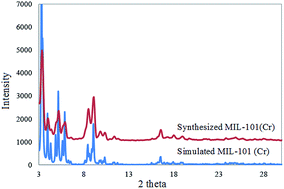Metal–organic framework enhanced electromembrane extraction – a conceptual study using basic drugs as model substances
Abstract
This work aims to use an appealing metal–organic framework (MOF), MIL-101(Cr), for the enhancement of electromembrane extraction efficiency. The use of MIL-101(Cr) in the supported liquid membrane (SLM) enhanced the analyte partition coefficient within the membrane, resulting in the enhancement of analyte transport. The optimization of the different variables affecting the proposed method was carried out in order to achieve the best extraction efficiency. Three narcotic drugs, including methadone, methamphetamine, and tramadol, were selected as model basic drugs. Optimal extractions were obtained with 2-nitrophenyl octyl ether, containing 2.0 mg mL−1 MIL-101(Cr) as the SLM and 125 V as the driving force with pHs of 4.0 and 1.0 for donor and acceptor solutions, respectively. Equilibrium extraction conditions were obtained after 25 min of operation with a stirring rate of 1250 rpm. Under the optimized extraction conditions, the proposed technique provided good linearity (>0.997), repeatability (RSD = 6.7–9.6%, n = 5), low limits of detection (0.30–0.91 ng mL−1), excellent preconcentration (132–190) and high recoveries (66–95%). Finally, the developed method coupled with CE-UV was successfully employed for the determination of the three narcotic basic drugs in biological samples, including plasma and urine.



 Please wait while we load your content...
Please wait while we load your content...